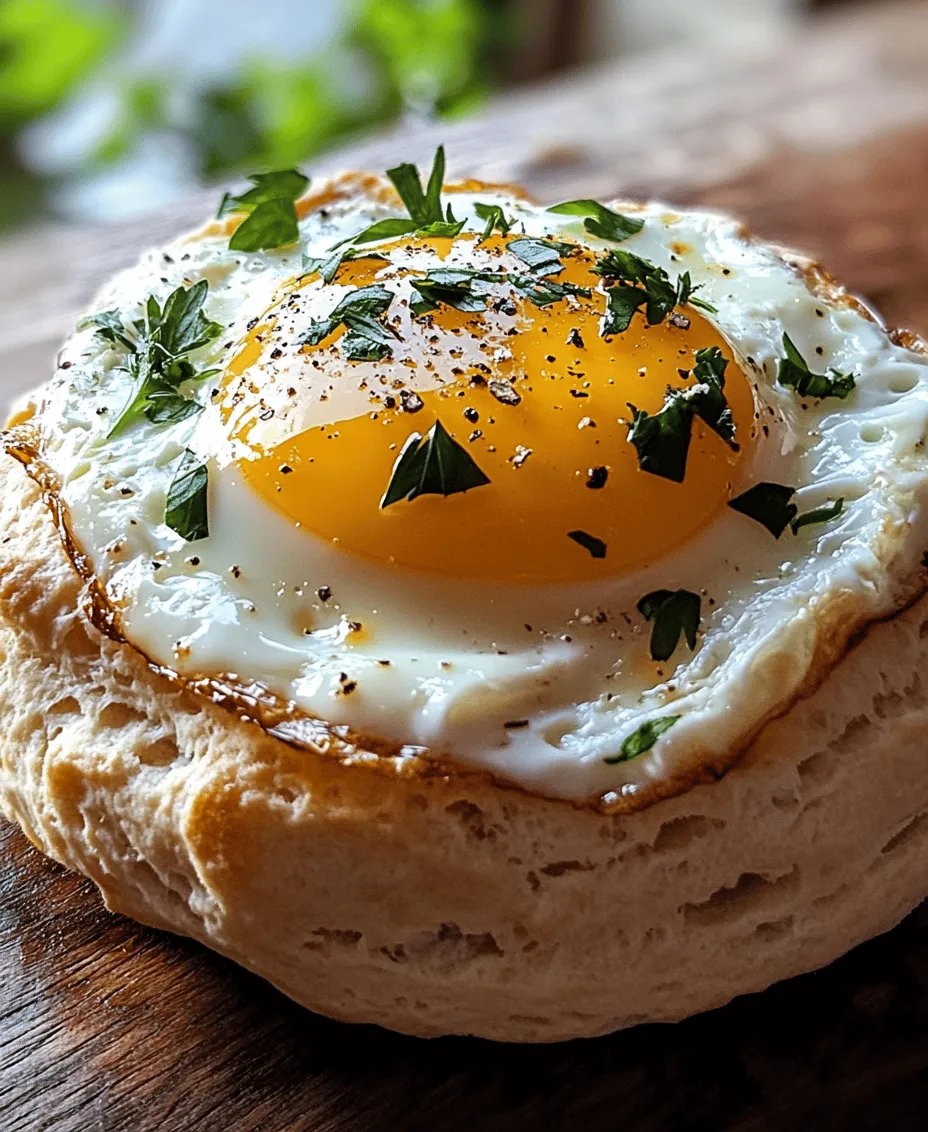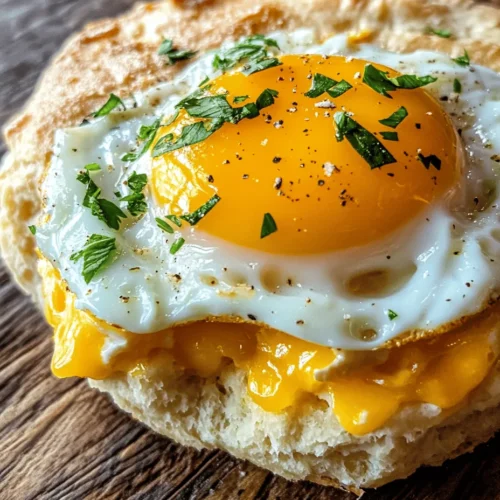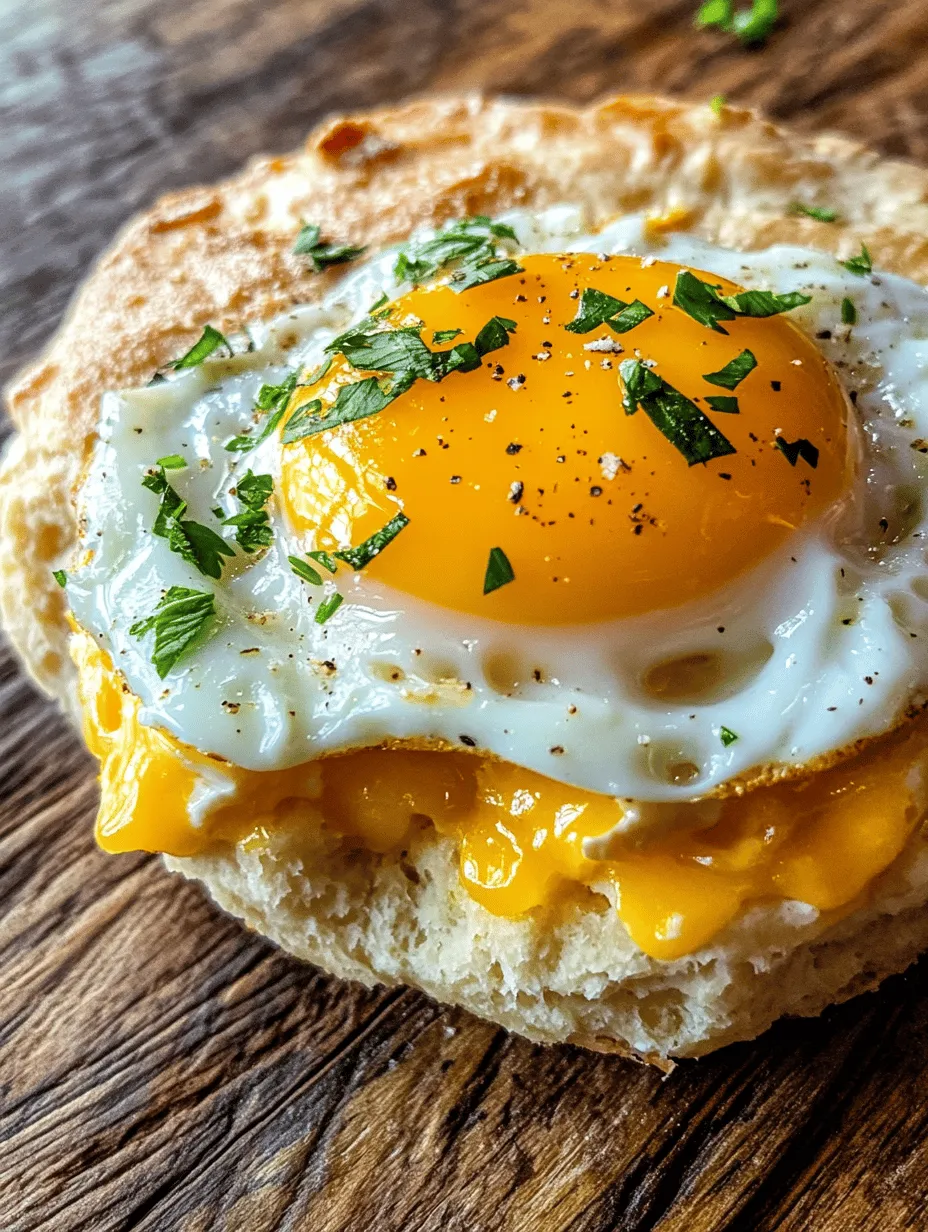In today’s fast-paced world, finding quick yet delicious breakfast options can be a challenge. Busy mornings often lead to rushed meals or unhealthy breakfast choices. Enter the “Egg in a Biscuit”—a delightful fusion of fluffy biscuits and perfectly baked eggs that promises to elevate your morning routine. This recipe not only offers convenience and flavor but also allows for personalization with your favorite cheeses and herbs. With its warm, comforting flavors and satisfying textures, Egg in a Biscuit is the breakfast treat that you didn’t know you needed.
The Origins of Egg in a Biscuit
To truly appreciate Egg in a Biscuit, it’s essential to explore the historical context of its key components: biscuits and eggs. Biscuits, a staple in Southern cuisine, trace their origins back to the European immigrants who settled in America. These early settlers brought with them the concept of quick bread, which eventually evolved into the flaky, buttery biscuits we know today. The use of baking powder, a modern innovation, allowed for lighter and fluffier biscuits, making them a versatile base for a variety of toppings.
Eggs, on the other hand, have long been celebrated for their nutritional value and culinary versatility. They are often referred to as the perfect protein, containing essential amino acids, vitamins, and minerals. The combination of eggs with biscuits has become a beloved breakfast tradition across many cultures, showcasing how simple ingredients can create a comforting meal.
When considering regional variations, the concept of baking eggs into bread products is not new. From the classic British breakfast dish of eggs baked in a pie crust to the French “Oeuf Cocotte,” where eggs are baked in a ramekin with cream and cheese, the idea of incorporating eggs into baked goods has been adapted in various forms. The rise of breakfast bakes in modern cuisine has only further popularized this concept, inviting home cooks to experiment with flavors and ingredients.
Egg in a Biscuit stands out as a contemporary interpretation of this tradition, merging the rich history of biscuits and eggs into a single, harmonious dish that caters to both taste and convenience. As we delve into this recipe, prepare to discover not only how to make this delightful breakfast treat but also the joy of crafting a meal that celebrates the simplicity of good ingredients and the comfort of home cooking.
Ingredients Breakdown for Egg in a Biscuit
Now that we have a grasp of the background of our dish, let’s take a closer look at the ingredients that come together to create this delicious breakfast delight. Understanding the key components will help you appreciate their roles in the final product and enable you to make informed choices when preparing Egg in a Biscuit.
Key Ingredients and Their Roles
1. All-Purpose Flour: The foundation of any biscuit, all-purpose flour provides the structure and body needed for a fluffy texture. When combined with fat and liquid, it forms gluten, which helps the biscuits rise and maintain their shape during baking.
2. Baking Powder: This leavening agent is essential for achieving that light and airy biscuit. It reacts with moisture and heat, releasing carbon dioxide gas that helps the dough rise and become fluffy.
3. Butter: For richness, flavor, and tenderness, butter is a crucial ingredient in biscuit-making. Cold butter, when cut into the flour, creates pockets of fat that melt during baking, resulting in flaky layers.
4. Milk or Buttermilk: Adding moisture to the biscuit dough, milk or buttermilk helps to bind the ingredients together. Buttermilk adds a tangy flavor and reacts with the baking powder for added leavening.
5. Eggs: The star of the dish, eggs add protein, flavor, and moisture. They serve as a binding agent and contribute to the overall richness of the Egg in a Biscuit.
The Importance of Fresh Herbs in Enhancing Flavor
While the base of the biscuit is simple, the addition of fresh herbs can elevate the flavor profile significantly. Popular options include chives, thyme, or parsley, which can add a burst of freshness and a delightful aroma. Using fresh herbs instead of dried ones is advisable, as they provide a vibrant flavor that dried herbs often lack. When incorporating herbs, consider finely chopping them and folding them into the biscuit dough for even distribution.
Choosing the Right Type of Cheese for Your Biscuits
Cheese is another opportunity for personalization in your Egg in a Biscuit recipe. Different types of cheese can contribute varying flavors and textures. Cheddar cheese is a classic choice, known for its sharpness and melting qualities. For a more sophisticated touch, consider using Gruyère or feta cheese, both of which will impart unique flavors to your biscuits. When selecting cheese, opt for high-quality, freshly grated cheese, as it will melt better and enhance the overall taste of your dish.
Preparation Steps for Egg in a Biscuit
With a solid understanding of the ingredients, it’s time to gather your tools and prepare your workspace. Proper preparation is crucial for achieving the best results when making Egg in a Biscuit.
Preparing Your Workspace: Tools and Equipment Needed
Before diving into the recipe, ensure you have the following tools on hand:
– Mixing Bowls: You’ll need several mixing bowls for combining dry ingredients, wet ingredients, and for mixing the biscuit dough.
– Muffin Tin: A standard muffin tin is required for shaping and baking the biscuits. You can also use a silicone muffin pan for easier release.
– Whisk and Pastry Cutter: A whisk is useful for combining dry ingredients, while a pastry cutter helps to cut in the butter for a flaky biscuit texture.
– Measuring Cups and Spoons: Accurate measurements are essential for baking. Use dry measuring cups for flour and sugar, and liquid measuring cups for milk and other liquids.
– Rolling Pin: If you plan to roll out your dough, a rolling pin will help achieve the desired thickness for your biscuits.
Preheating the Oven: Why Temperature Matters
Before you start mixing ingredients, preheat your oven to 400°F (200°C). Preheating is a crucial step in baking, as it ensures that your biscuits will rise properly and cook evenly. An oven that is too cool can lead to dense biscuits, while an overly hot oven may cause them to brown too quickly without cooking through.
Making the Biscuit Dough: Tips for Perfect Texture
To achieve the perfect biscuit texture, follow these steps:
1. Combine Dry Ingredients: In a large mixing bowl, whisk together the all-purpose flour, baking powder, and a pinch of salt. This ensures even distribution of the leavening agent and seasoning.
2. Cut in the Butter: Using a pastry cutter or your fingers, cut cold, cubed butter into the flour mixture until it resembles coarse crumbs. The key is to work quickly to keep the butter cold, as this will create the desired flakiness.
3. Add Wet Ingredients: Make a well in the center of the flour mixture and pour in the milk or buttermilk. Use a fork or a spatula to gently mix until just combined. Overmixing can lead to tough biscuits, so it’s important to mix until the ingredients are just incorporated.
4. Incorporate Cheese and Herbs: If you’re adding cheese and herbs, fold them in gently at this stage. This will allow the flavors to distribute evenly throughout the dough without overworking it.
Filling the Muffin Tin: Techniques for Even Distribution
Once your dough is prepared, it’s time to fill the muffin tin:
1. Divide the Dough: Lightly flour your work surface and turn the biscuit dough out onto it. Divide the dough into equal portions, depending on how many biscuits you plan to make. Typically, this recipe yields about 8 biscuits.
2. Shape the Biscuits: Using your hands, gently shape each portion into a round ball or flatten it slightly. Avoid using too much flour, as this can make the biscuits tough.
3. Grease the Muffin Tin: Lightly grease your muffin tin with cooking spray or butter to prevent sticking. If you’re using a silicone muffin pan, greasing is optional.
4. Place the Dough in the Tin: Carefully place each biscuit portion into the muffin tin, ensuring they are spaced evenly. This allows for even cooking and helps the biscuits rise together.
Adding the Eggs: Ensuring Perfectly Cooked Eggs
The final step before baking is to add the eggs:
1. Create a Well: Using your thumb or the back of a spoon, create a small well in the center of each biscuit dough portion. This will hold the egg in place during baking.
2. Crack the Eggs: Gently crack an egg into each well, being careful not to break the yolk. If you prefer, you can also whisk the eggs beforehand and pour a small amount into each well. This allows for a more uniform distribution of egg throughout your biscuits.
3. Season the Eggs: For added flavor, sprinkle a pinch of salt and pepper over the eggs. You can also add a sprinkle of cheese or additional herbs at this stage for extra richness and flavor.
With your muffin tin filled and ready, you are now prepared to bake your Egg in a Biscuit. The combination of flaky, buttery biscuits and perfectly baked eggs makes this dish a breakfast delight that is sure to please.
In the next part of this article, we will guide you through the baking process and provide tips for achieving the best results. Stay tuned for the delicious finishing touches that will make your Egg in a Biscuit a standout breakfast choice!

Understanding Baking Times and Temperature
When it comes to baking the perfect Egg in a Biscuit, mastering the right baking times and temperatures is crucial. Generally, you’ll want to preheat your oven to 375°F (190°C). This temperature allows the biscuits to rise beautifully while ensuring that the egg cooks to a perfect consistency.
Baking for approximately 15-20 minutes is usually ideal, but keep an eye on them. The goal is to achieve a golden-brown exterior while ensuring the egg is set but not overcooked. Remember, every oven is different, so you may need to adjust your time slightly.
How to Check for Doneness: Tips for Perfect Results
To ensure your Egg in a Biscuit is cooked to perfection, there are a few simple tips you can follow. First, look for a golden-brown crust on the biscuit. This color indicates that the dough has baked through properly.
Next, gently shake the baking sheet; if the biscuit feels firm and the egg is slightly jiggly but not runny, it’s ready. If you want to be extra cautious, you can use a toothpick to test the biscuit portion. Insert it into the biscuit, and if it comes out clean or with just a few moist crumbs, the dish is done.
Common Baking Mistakes to Avoid
While baking can be straightforward, there are common mistakes that can hinder your Egg in a Biscuit experience. One common error is overworking the biscuit dough. When combining the dry and wet ingredients, mix just until combined; overmixing can lead to tough biscuits.
Another common issue is neglecting to preheat your oven. Baking in an unheated oven can result in uneven cooking, affecting both the texture and flavor. Finally, remember to check for doneness before the time is up. Ovens can vary significantly, and you don’t want to risk overbaking the egg.
Serving Suggestions for Egg in a Biscuit
Creative Ways to Serve: Pairing with Sides and Drinks
Egg in a Biscuit is a versatile dish that pairs well with a variety of sides and beverages. For a complete breakfast, consider serving it alongside fresh fruit like sliced strawberries, blueberries, or a side of mixed melons. These fruits add a refreshing contrast to the warm, hearty biscuit.
For a heartier meal, pair your Egg in a Biscuit with crispy bacon or sausage links. The savory flavors of the meat complement the richness of the egg and biscuit beautifully.
When it comes to drinks, consider serving freshly brewed coffee or a robust herbal tea. For a more refreshing option, a glass of freshly squeezed orange juice can brighten up the meal and add a touch of sweetness.
Presentation Ideas for Breakfast and Brunch
Presentation can elevate your Egg in a Biscuit from a simple breakfast to a stunning brunch centerpiece. Start by serving the biscuits on a rustic wooden board or a vibrant serving platter. This adds a touch of charm and invites guests to help themselves.
Garnish with sprigs of fresh herbs like chives or parsley for a pop of color and flavor. Consider adding a small bowl of homemade jam or honey on the side for those who enjoy a sweet contrast to the savory dish.
If you’re hosting a brunch, consider creating an “Egg in a Biscuit bar” where guests can customize their biscuits with different toppings such as avocado slices, salsa, or cheese. This interactive element can make your brunch gathering even more memorable.
Storing and Reheating Leftovers: Best Practices
If you find yourself with leftover Egg in a Biscuit, don’t worry; they store well! Allow the biscuits to cool completely before transferring them to an airtight container. They can be stored in the refrigerator for up to three days.
To reheat, place the biscuits in an oven preheated to 350°F (175°C) for about 10-15 minutes, or until warmed through. This method will help maintain their texture and flavor. Alternatively, you can microwave them for about 30 seconds, but keep in mind that this may make the biscuit slightly softer.
Nutritional Value of Egg in a Biscuit
Analyzing the Nutritional Content of the Key Ingredients
Understanding the nutritional content of your Egg in a Biscuit can help you appreciate its health benefits. Eggs are a great source of protein, healthy fats, and essential vitamins and minerals, including Vitamin D and B12. The biscuit base, while typically higher in carbohydrates, can be made healthier by using whole wheat flour or a gluten-free alternative.
Additionally, adding vegetables like spinach or bell peppers to the egg mixture can enhance the nutritional profile, providing fiber, vitamins, and antioxidants. If you’re looking to reduce fat, consider using egg whites or low-fat cheese.
Balancing Flavors with Nutritional Needs
Creating a balanced dish means considering both flavor and nutrition. While the buttery biscuit and rich egg provide satisfying flavors, incorporating herbs and spices can enhance the taste without adding extra calories. Fresh herbs like basil or dill can add a burst of freshness, while spices like paprika or black pepper can add warmth and depth.
Customization for Dietary Restrictions: Gluten-Free and Dairy-Free Options
For those with dietary restrictions, customizing your Egg in a Biscuit is entirely possible. To make it gluten-free, substitute regular flour with a gluten-free blend designed for baking. Ensure that all other ingredients, such as baking powder, are also gluten-free.
If you’re looking to make it dairy-free, you can easily substitute butter with coconut oil or a dairy-free margarine. Additionally, consider using a dairy-free cheese option or simply omit cheese altogether. These adjustments ensure that everyone can enjoy this delightful recipe without compromising on taste.
Cultural Significance of Breakfast Foods
The Role of Breakfast in Different Cultures
Breakfast is often referred to as the most important meal of the day, and different cultures around the world have their unique takes on it. In many Western cultures, breakfast typically includes eggs, bread, or pastries, much like our Egg in a Biscuit.
In contrast, other cultures may prioritize grains, fruits, or hearty dishes. For instance, in Japan, a traditional breakfast might include rice, miso soup, and grilled fish. In Mexico, chilaquiles or huevos rancheros are popular choices. These differences highlight the diversity and cultural significance of breakfast foods globally.
How Dishes Like Egg in a Biscuit Fit into the Breakfast Landscape Globally
Dishes like Egg in a Biscuit reflect the global love for combining eggs and bread. The concept of placing an egg atop a baked good is found in many cultures, from the French croissant with a soft-boiled egg to the classic English breakfast featuring eggs and toast.
Egg in a Biscuit brings together elements that are comforting and satisfying, making it a beloved breakfast choice in its own right. Its versatility allows it to be adapted to different tastes and preferences, further emphasizing its universal appeal.
Conclusion: Enjoying Your Homemade Egg in a Biscuit
Creating and sharing food brings joy and connection, and making your own Egg in a Biscuit is no exception. This simple yet delightful recipe allows for creativity and customization, making it an excellent choice for breakfast or brunch gatherings.
Encouraging experimentation with flavors and ingredients can lead to exciting variations of this classic dish. Perhaps try adding different herbs, spices, or sides to discover new favorites.
The lasting appeal of simple, comforting breakfast recipes like Egg in a Biscuit lies in their ability to bring people together around the table. Whether served at a casual family breakfast or a festive brunch, this dish is sure to be a hit. So gather your ingredients, preheat your oven, and enjoy the process of creating something delicious to share with those you love.



